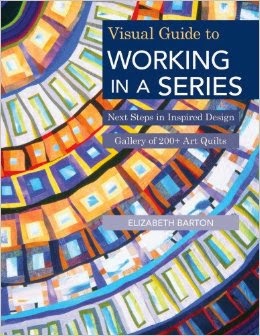
A question that all of us come to sooner or later is
Why?
Why do people make art?
Jane Dunnewold asked this is in a blog a few days ago and it set me off cogitating – again!
I think the answer is definitely part of a wider picture of what it means to be a human being. All kids love to play and “make” things but as they grow up some (alas many) get this drive beaten out of them by “education” and passive entertainment and reinforcement for being consumers rather than makers. If you think about it most external reinforcement is for consuming and not for making. Even kids take part in that – many preferring “bought” cake to the home made variety…… but only, I think, because of all the advertising…though I must admit my Dad always preceded his strange homemade buns and cakes by “I made another mistake for your tea”! (aside: “tea” when I grew up was a meal you ate at 4 o’clock every afternoon and it was lovely! there were so many more meals back then but even so, obesity was less of a problem). Thankfully, some of his “mistakes” were quite successful! Others were enjoyed by the dog who knew absolutely where to position herself when she heard the word “mistake”!.

But back to
Why. I have not looked up loads of research on this so if someone knows of it – please comment!- but I think making stuff is because we think a lot and, in our thinking, we ask questions about change. What if I change this surface? What if I add this to this? Would they go together? Inventiveness has to be linked to survival. If conditions change, we need to invent a new way of finding food or shelter. And that’s just the practical side of things. So, why do we go beyond that into more decorative? And by “decorative” I mean merely things to look at rather than things with a particular practical function. And I find that women more than men (though not of course exclusively) are concerned about things look. I don’t know why this is, but I presume it is linked to survival again…the man is primed to act, the woman to observe…the woman sees what needs to be done and the man has the extra strength to do it. Jane asks why are woman over represented in textile arts, I would say that women and men with a strong feminine side to their way of thinking are over represented in
all the arts. Very masculine men are rarely making art, they’re out there
doing or, at least, watching others doing. They like to see things moving not how they are.
We are born with the desire to play and make things. And as to the medium we use, I think we make things with the tools we have available to us, or that we are encouraged to use – by parents, by society, by teachers. In some societies it is the men that sew not the women, they were the ones given the needle and thread when they were little.

After childhood, some people give up, and others continue, finding the need to create something ever stronger. Why do they continue? That’s the real question. In simplistic terms I think it relates to what effect either the made object and or the making of the object has upon us. What happens when we make it? Is there a release of the “making desire”? Is there reinforcement (whether it be internal or external) for the made object? If you listen to responses to the question
Why d’you make art? you will hear both of these things. Some say “well I get irritable if I’m not making” (desire released), other say “it’s so fulfilling to see something I made hanging in a gallery” (external reinforcement), others reply “I feel good about myself when I’ve made something” (internal reinforcement).
It’s also a matter of time. In current society there is very little time for play or making things after childhood and it’s not encouraged at all. When I was a highschooler and university student messing around with paints or thread was considered to be a distraction – “get back to your books!”. However, as people retire, many of them begin to make things again. And that’s great…for now there is a reason to every day. Some make for enjoyment, some make because they want to develop a skill – a skill that is so incredibly fulfilling that it will make you joyful for the dawn of every new day.

so ….what d’you think? why ARE we making these “quilts” that really have no practical use at all??!!
And, if you have been, thanks for reading! Elizabeth
PS Or, is the real question, why isn't everyone making something? As human beings I think our default mode originally (before tv, eating out,shopping, bringing work home from the office etc etc) was to be creative and make things.































































